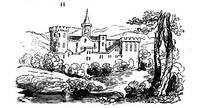90. The transition from the Roman villas to the Italian castles or monastic establishments of the middle ages was decidedly unfavourable to gardening. When the Goths took possession of Italy the whole country was divided among their military barons, each of whom had his castle, within the walls of which he shut up himself and his vassals when he was at war with his neighbours. In this state of society, there could of course be no gardens, but those contained in the quadrangles of the castles. In later and more peaceful times, when wealthy citizens began to venture to indulge a taste for a country life, and when monasteries began to be erected, both were frequently engrafted on the remains of Roman villas; and, as Castellan observes, retained the ancient distribution of the parts of the buildings: the courts surrounded with porticoes, which were used for walks; the rooms entering upon the portico, without communicating with one another; the basins, with fountains in the courts; the terraces upon arcades; the oratories in the gardens; � all had a striking analogy to the ancient villa. At an ancient villa near Brundusium our author found the ambulacrum, or covered walk of the Romans, pretty entire. Meason, in his Landscape Architecture of Italy, has given several engravings taken from the pictures of the ancient Italian painters, which show the different forms assumed by these anomalous buildings. In fig. 9., from Titian, we see an Italian baronial castle built only for defence, and consisting entirely of round towers, with one more elevated than the rest to serve as a watch tower. These watch towers were almost indispensable in a flat country like that of great part of Italy; and their form is still preserved in the campanile or belvidere of the modern Italian villa. Sometimes an anomalous building, half castle, half monastery, was erected on the Roman ruins, and an example of this kind is shown in fig. 10. from the background of a picture of Giotto; and another (fig. 11.) from Julio Romano. One of the latest examples of a house of this kind is shown in fig. 12. It was the residence of Francesco Solimene, a Neapolitan painter, who died in it in 1747, at the age of 90; and it was situated at the foot of Mount Vesuvius, Fig. 13. is another sketch from Meason's Landscape Architecture, It is from one of the paintings of Breemberg, who, from his long residence in Italy, acquired much of an Italian taste in his painting; and it would form a very ornamental object to introduce in pleasure-grounds, in rocky scenery.









